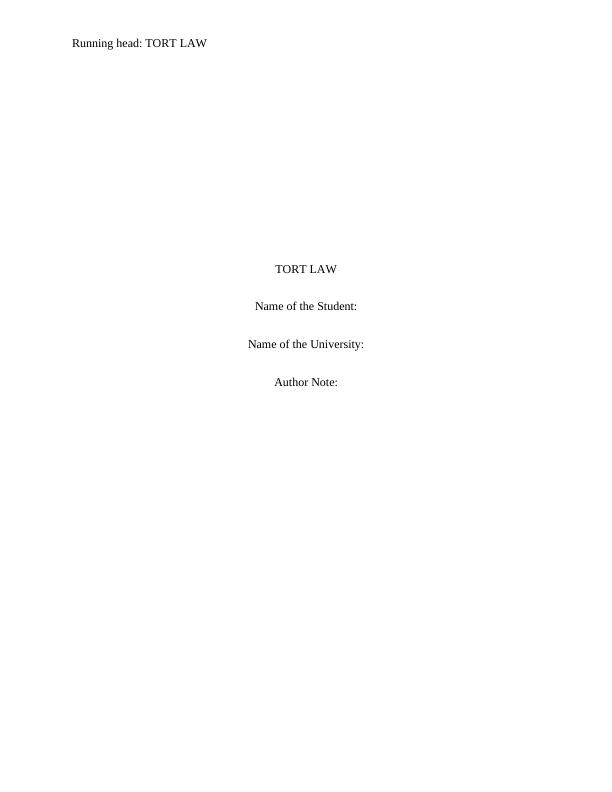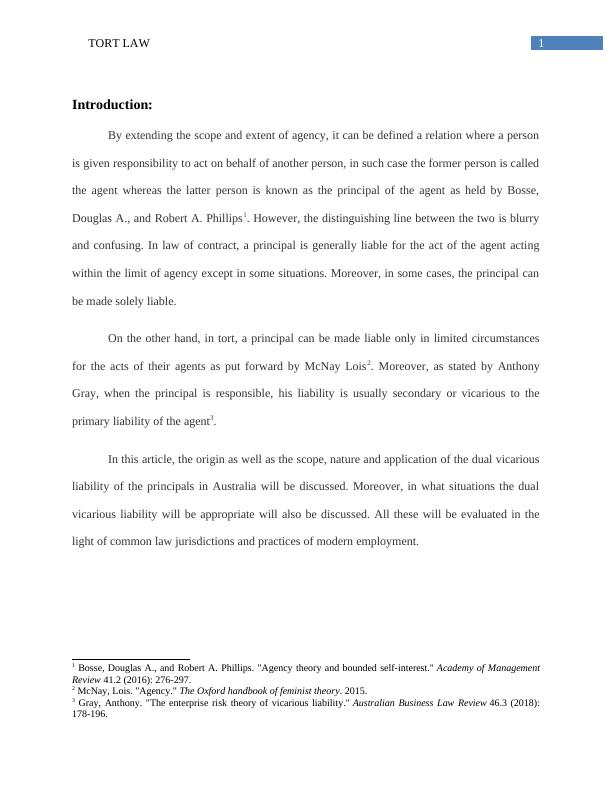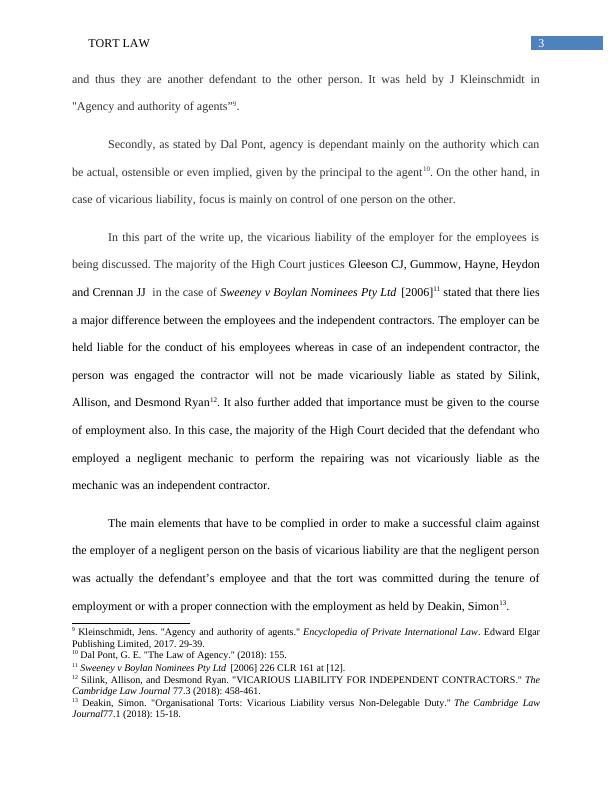Tort Law: Scope and Application of Dual Vicarious Liability in Australia
Added on 2022-11-25
17 Pages4579 Words116 Views
Running head: TORT LAW
TORT LAW
Name of the Student:
Name of the University:
Author Note:
TORT LAW
Name of the Student:
Name of the University:
Author Note:

1TORT LAW
Introduction:
By extending the scope and extent of agency, it can be defined a relation where a person
is given responsibility to act on behalf of another person, in such case the former person is called
the agent whereas the latter person is known as the principal of the agent as held by Bosse,
Douglas A., and Robert A. Phillips1. However, the distinguishing line between the two is blurry
and confusing. In law of contract, a principal is generally liable for the act of the agent acting
within the limit of agency except in some situations. Moreover, in some cases, the principal can
be made solely liable.
On the other hand, in tort, a principal can be made liable only in limited circumstances
for the acts of their agents as put forward by McNay Lois2. Moreover, as stated by Anthony
Gray, when the principal is responsible, his liability is usually secondary or vicarious to the
primary liability of the agent3.
In this article, the origin as well as the scope, nature and application of the dual vicarious
liability of the principals in Australia will be discussed. Moreover, in what situations the dual
vicarious liability will be appropriate will also be discussed. All these will be evaluated in the
light of common law jurisdictions and practices of modern employment.
1 Bosse, Douglas A., and Robert A. Phillips. "Agency theory and bounded self-interest." Academy of Management
Review 41.2 (2016): 276-297.
2 McNay, Lois. "Agency." The Oxford handbook of feminist theory. 2015.
3 Gray, Anthony. "The enterprise risk theory of vicarious liability." Australian Business Law Review 46.3 (2018):
178-196.
Introduction:
By extending the scope and extent of agency, it can be defined a relation where a person
is given responsibility to act on behalf of another person, in such case the former person is called
the agent whereas the latter person is known as the principal of the agent as held by Bosse,
Douglas A., and Robert A. Phillips1. However, the distinguishing line between the two is blurry
and confusing. In law of contract, a principal is generally liable for the act of the agent acting
within the limit of agency except in some situations. Moreover, in some cases, the principal can
be made solely liable.
On the other hand, in tort, a principal can be made liable only in limited circumstances
for the acts of their agents as put forward by McNay Lois2. Moreover, as stated by Anthony
Gray, when the principal is responsible, his liability is usually secondary or vicarious to the
primary liability of the agent3.
In this article, the origin as well as the scope, nature and application of the dual vicarious
liability of the principals in Australia will be discussed. Moreover, in what situations the dual
vicarious liability will be appropriate will also be discussed. All these will be evaluated in the
light of common law jurisdictions and practices of modern employment.
1 Bosse, Douglas A., and Robert A. Phillips. "Agency theory and bounded self-interest." Academy of Management
Review 41.2 (2016): 276-297.
2 McNay, Lois. "Agency." The Oxford handbook of feminist theory. 2015.
3 Gray, Anthony. "The enterprise risk theory of vicarious liability." Australian Business Law Review 46.3 (2018):
178-196.

2TORT LAW
Discussion:
It is observed in the recent days that the Supreme Court of United Kingdom has been
generously expanding the scope of the situations where vicarious liability can be applied.
However, the approach followed in Australian courts is contrast to that of UK courts as argued
by Simon Deakin4. In the case of Prince Alfred College Inc v ADC [2016], the High Court of
Australia restated the law involving vicarious liability and while doing it confirmed that there
lies a significant difference between the laws of Australia and UK in this regard5. The decision of
the High Court calls for analysis and discussion for mainly two causes; firstly that the UK courts
have paid close attention to the approach of the Australian authority on vicarious liability. In the
cases of Lister v Hesley Hall Ltd [2001]6 and Dubai Aluminium Co Ltd v Salaam [2002]7,
Australian law is discussed. Similar observation was also found in the landmark cases of
Mohamud v Wm Morrison Supermarkets plc [2016]8. The second reason is that it is important to
reflect on the differences between the laws of vicarious liability observed in Australia and the
UK and to consider the causes behind such difference.
Liability on the basis of agency and vicarious liability can be differentiated on two
grounds; firstly, in the law of agency, a principal is depicted as if he actually did whatever his
agent has done and hence there lies only one defendant whereas under the concept of vicarious
liability, a person who is vicariously responsible is liable jointly for the tort of another person
4 Deakin, Simon. "Organisational Torts: Vicarious Liability versus Non-Delegable Duty." The Cambridge Law
Journal77.1 (2018): 15-18.
5 Prince Alfred College Inc v ADC [2016] HCA 37.
6 Lister v Hesley Hall Ltd [2001] UKHL 22 [81].
7Dubai Aluminium Co Ltd v Salaam [2002] UKHL 48 [32].
8 Mohamud v Wm Morrison Supermarkets plc [2016] UKSC 11 [29].
Discussion:
It is observed in the recent days that the Supreme Court of United Kingdom has been
generously expanding the scope of the situations where vicarious liability can be applied.
However, the approach followed in Australian courts is contrast to that of UK courts as argued
by Simon Deakin4. In the case of Prince Alfred College Inc v ADC [2016], the High Court of
Australia restated the law involving vicarious liability and while doing it confirmed that there
lies a significant difference between the laws of Australia and UK in this regard5. The decision of
the High Court calls for analysis and discussion for mainly two causes; firstly that the UK courts
have paid close attention to the approach of the Australian authority on vicarious liability. In the
cases of Lister v Hesley Hall Ltd [2001]6 and Dubai Aluminium Co Ltd v Salaam [2002]7,
Australian law is discussed. Similar observation was also found in the landmark cases of
Mohamud v Wm Morrison Supermarkets plc [2016]8. The second reason is that it is important to
reflect on the differences between the laws of vicarious liability observed in Australia and the
UK and to consider the causes behind such difference.
Liability on the basis of agency and vicarious liability can be differentiated on two
grounds; firstly, in the law of agency, a principal is depicted as if he actually did whatever his
agent has done and hence there lies only one defendant whereas under the concept of vicarious
liability, a person who is vicariously responsible is liable jointly for the tort of another person
4 Deakin, Simon. "Organisational Torts: Vicarious Liability versus Non-Delegable Duty." The Cambridge Law
Journal77.1 (2018): 15-18.
5 Prince Alfred College Inc v ADC [2016] HCA 37.
6 Lister v Hesley Hall Ltd [2001] UKHL 22 [81].
7Dubai Aluminium Co Ltd v Salaam [2002] UKHL 48 [32].
8 Mohamud v Wm Morrison Supermarkets plc [2016] UKSC 11 [29].

3TORT LAW
and thus they are another defendant to the other person. It was held by J Kleinschmidt in
"Agency and authority of agents”9.
Secondly, as stated by Dal Pont, agency is dependant mainly on the authority which can
be actual, ostensible or even implied, given by the principal to the agent10. On the other hand, in
case of vicarious liability, focus is mainly on control of one person on the other.
In this part of the write up, the vicarious liability of the employer for the employees is
being discussed. The majority of the High Court justices Gleeson CJ, Gummow, Hayne, Heydon
and Crennan JJ in the case of Sweeney v Boylan Nominees Pty Ltd [2006]11 stated that there lies
a major difference between the employees and the independent contractors. The employer can be
held liable for the conduct of his employees whereas in case of an independent contractor, the
person was engaged the contractor will not be made vicariously liable as stated by Silink,
Allison, and Desmond Ryan12. It also further added that importance must be given to the course
of employment also. In this case, the majority of the High Court decided that the defendant who
employed a negligent mechanic to perform the repairing was not vicariously liable as the
mechanic was an independent contractor.
The main elements that have to be complied in order to make a successful claim against
the employer of a negligent person on the basis of vicarious liability are that the negligent person
was actually the defendant’s employee and that the tort was committed during the tenure of
employment or with a proper connection with the employment as held by Deakin, Simon13.
9 Kleinschmidt, Jens. "Agency and authority of agents." Encyclopedia of Private International Law. Edward Elgar
Publishing Limited, 2017. 29-39.
10 Dal Pont, G. E. "The Law of Agency." (2018): 155.
11 Sweeney v Boylan Nominees Pty Ltd [2006] 226 CLR 161 at [12].
12 Silink, Allison, and Desmond Ryan. "VICARIOUS LIABILITY FOR INDEPENDENT CONTRACTORS." The
Cambridge Law Journal 77.3 (2018): 458-461.
13 Deakin, Simon. "Organisational Torts: Vicarious Liability versus Non-Delegable Duty." The Cambridge Law
Journal77.1 (2018): 15-18.
and thus they are another defendant to the other person. It was held by J Kleinschmidt in
"Agency and authority of agents”9.
Secondly, as stated by Dal Pont, agency is dependant mainly on the authority which can
be actual, ostensible or even implied, given by the principal to the agent10. On the other hand, in
case of vicarious liability, focus is mainly on control of one person on the other.
In this part of the write up, the vicarious liability of the employer for the employees is
being discussed. The majority of the High Court justices Gleeson CJ, Gummow, Hayne, Heydon
and Crennan JJ in the case of Sweeney v Boylan Nominees Pty Ltd [2006]11 stated that there lies
a major difference between the employees and the independent contractors. The employer can be
held liable for the conduct of his employees whereas in case of an independent contractor, the
person was engaged the contractor will not be made vicariously liable as stated by Silink,
Allison, and Desmond Ryan12. It also further added that importance must be given to the course
of employment also. In this case, the majority of the High Court decided that the defendant who
employed a negligent mechanic to perform the repairing was not vicariously liable as the
mechanic was an independent contractor.
The main elements that have to be complied in order to make a successful claim against
the employer of a negligent person on the basis of vicarious liability are that the negligent person
was actually the defendant’s employee and that the tort was committed during the tenure of
employment or with a proper connection with the employment as held by Deakin, Simon13.
9 Kleinschmidt, Jens. "Agency and authority of agents." Encyclopedia of Private International Law. Edward Elgar
Publishing Limited, 2017. 29-39.
10 Dal Pont, G. E. "The Law of Agency." (2018): 155.
11 Sweeney v Boylan Nominees Pty Ltd [2006] 226 CLR 161 at [12].
12 Silink, Allison, and Desmond Ryan. "VICARIOUS LIABILITY FOR INDEPENDENT CONTRACTORS." The
Cambridge Law Journal 77.3 (2018): 458-461.
13 Deakin, Simon. "Organisational Torts: Vicarious Liability versus Non-Delegable Duty." The Cambridge Law
Journal77.1 (2018): 15-18.

End of preview
Want to access all the pages? Upload your documents or become a member.
Related Documents
Agency Law and Liability: A Case Study on Steve and Biancalg...
|6
|1943
|301
Empire Courier Case Analysislg...
|4
|744
|133
Analysis of Watteau v Fenwick Caselg...
|16
|4538
|379
Corporations and Business Law Case Study Assignmentlg...
|23
|1629
|282
Corporations and Business Law: Case Study Assignmentlg...
|9
|2365
|387
Concept of Vicarious Liability - Employment & Agency Lawlg...
|4
|699
|476
